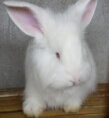

长毛兔科学饲养的注意事项
 发布日期:2016-03-18
来源:http://www.myxinhua.com 发布人:admin
发布日期:2016-03-18
来源:http://www.myxinhua.com 发布人:admin
科学的饲养管理是养好长毛兔的关键。我们蒙阴长毛兔(长毛兔之乡-蒙阴长毛兔)实践证明,如果饲养管理不当,即使有和种兔、丰富的饲料、 合适的笼舍,也得不到良好的饲养效果和经济效益。但是要想养好长毛兔,必须根据长毛兔的习性和行为,在饲养管理过程中,注意以下基本原则:
Feeding and management science is the key to raise Angora rabbit. We Mengyin Angora rabbit (Angora Rabbit Town - Mengyin Angora rabbit) practice has proved that if keeping mismanagement, even if there are excellent and kind of hare, rich feed, suitable cages, not to good feeding effect and economic benefit. But if you want to keep a good Angora Angora rabbit, must according to the habits and behaviors in the process of feeding and management, pay attention to the following basic principles:

1、忌喂单一配料
avoid feeding a single ingredient
长毛兔生长快,繁殖力强,体内代谢旺盛,加之生产兔毛需要各种营养与代谢过程。所以,饲喂长毛兔的饲料不仅要注意营养物质的数量,还要考虑到质量,要强调饲料的合理搭配,严禁用单一饲料饲喂长毛兔。俗话说“若要兔子好,饲喂百样草”。
Angora rabbit fast growth, fecundity, strong metabolism, and the need to all kinds of nutrition and metabolism of rabbit production. Therefore, the feeding of Angora rabbit feed should not only pay attention to the quantity of nutrients, but also consider the quality, reasonable collocation to emphasize feed, prohibit the use of a single feed of Angora rabbit. As the saying goes, "if the rabbit, feeding like 100 grass".
2、喂料方面,草料为主,精料为辅
feed, forage, concentrate supplement
长毛兔为草食动物,饲料应以草料为主,精料为辅。据试验,没有草光有料是养不好长毛兔的,一般青粗饲料应占全部日粮50%~70%。长毛兔采食青粗饲料的数量,大致为本身体重的10%~30%。
Angora rabbit for herbivorous animal feed, to forage, concentrate supplement. According to the test, there is no grass light material raising good Angora rabbit, general green forage total diet 50%~70%. Angora rabbit production number of eating roughage, approximately 10%~30% of their body weight.
3、定时定量喂养
timing quantitative feeding
定时定量饲喂长毛兔可使兔子养成良好采食习惯, 增进食欲,喂料次数以3~5次/d为宜。但在喂饲过程中还必须做到“五看”:一看兔体大小投料,不能一律对待;二看兔子肥瘦程度投料;三看粪便干湿度投料;四看饥饱 情况投料;五看天气冷热情况喂料。
Quantitative feeding time of Angora rabbit can make the rabbit develop good feeding habits, appetite and feeding times to 3~5 times /d. But in the feeding process must also do "Five": a look at feeding rabbit body size, cannot treat in the same way; second, look at the degree of rabbit fat feeding; three fecal dry humidity feeding; four to see hunger and satiety of feeding; 5 at the weather hot and cold feed.
4、注意品质饲料品质
pay attention to the quality of feed quality
长毛兔对饲料的选择比较严格,合理调制可明显提高饲料的适口性和消化率。生产实践证明,要想养好长毛兔,还必须注意饲草、饲料的品质。做到以下“十不喂”:一不喂霉烂、变质饲料;二不喂带泥沙、粪污的饲料;三不喂带雨、露水的青绿饲料;四不喂带农药等毒 物污染的饲料;五不喂冰冻饲料;六不喂发芽马铃薯和带黑斑病的甘薯;七不喂未经蒸煮或焙烤的豆类饲料; 八不喂有毒植物;九不喂大量牛皮菜、菠菜等;十不喂大量紫云英等青绿饲料。
Choose to feed the Angora rabbit is very strict, reasonable modulation can significantly improve the palatability and digestibility of feed. The production practice shows that in order to keep a good Angora rabbit, also must pay attention to the quality of forage. Do the following "ten not fed": a do not feed mildew, feed metamorphism; second, do not feed with mud and dung feed; three do not feed with rain and dew green feed; feed four belt fed pesticide poison pollution; five do not feed feed frozen; six do not feed the germination of potato and sweet potato with black spot; seven do not feed not by cooking or baked beans for feed, do not feed poisonous plants; nine do not feed a large number of Swiss chard, spinach and; ten do not feed green feed for a large number of Chinese milk vetch.
5、保持安静,注意卫生
keep quiet, pay attention to health
兔子胆小,一旦受惊或受追捕、转群等应激因素的影响,就会引起精神不安,食欲减退,甚患病死亡。为保持安静,保证长毛兔的正常生长和生产,必须注意三点:一是兔舍必须保持安静;二是为防止疾病传染, 兔场应谢绝参观,非兔舍管理人员严禁入内;三是笼舍应每天打扫,及时粪便,定期洗刷饲具,,保持卫生。
Rabbit timid, once frightened or subject to hunt, the impact of the group and other stress factors, it will cause mental discomfort, loss of appetite, and even death. To keep quiet, to ensure normal growth and production of Angora rabbit, must pay attention to three points: one is the rabbit must keep quiet; the second is to prevent the disease from spreading, Warren should decline to visit, non rabbit hutch management personnel are not allowed to enter the inside; the third is the cage should be cleaned every day, removing manure promptly and regularly wash feed, disinfection, and maintain health.